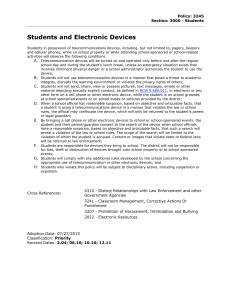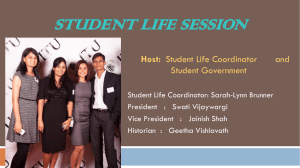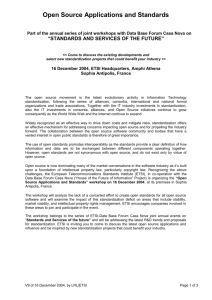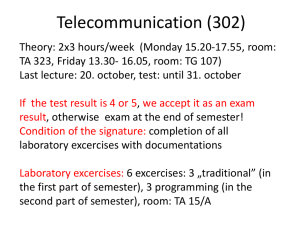Telecommunication Standards
advertisement
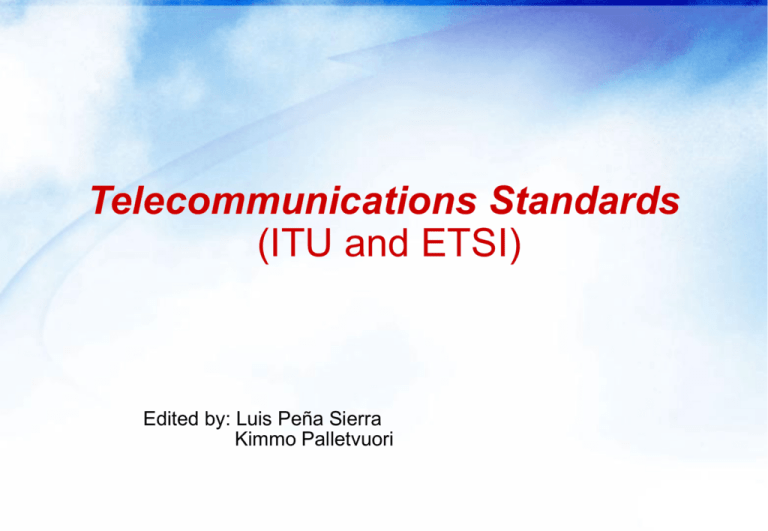
Telecommunications Standards (ITU and ETSI) Edited by: Luis Peña Sierra Kimmo Palletvuori Content • Standards overview • ITU history • ITU Structure • Radiocommunication sector in ITU • Telecommunication sector in ITU • Telecommunication Development sector in ITU • ITU current activities • Forums/Consortia cooperating with ITU • References Standards Overview • Why the standards are needed? 1. Interoperability 2. Quality insurance 3. Consistency in Evolution • Bodies of standardization 1. International or Government (ITU) 2. Semi-official (ETSI) 3. Volunteer Organizations (3GPP, 3GGP2) ITU-R ITU-T ITU-D 1865 International Telegraph Union ITU History 1992 three sectors in ITU 1885 ITU start with telephony 1903 ITU first wireless telegraphy 1906 first radiotelegraph convention 1947 UN specialized agency for telecommunications 1948 ITU headquarters transferred to Geneva 1932 Combining Telegraph and Radiotelegraph International Telecommunication Union Plenipotentiary Conference: Convention and Constitution document (every 4 years) Radiocommunications Conference Telecommunications Conference Telecommunication development communications Conference Radiocommunication Sector SG1, Spectrum Management Principles and techniques for spectrum management, methods and techniques SG3, Radiowave propagation Propagation of radio waves in ionised and nonionised media, radio noise SG4, Fixed-Satellite services Systems and networks for the fixed-satellite service and inter-satellite links. SG6, Broadcasting services Including vision, sound, multimedia and data services for general public ITU-R SG7, Science services Systems for space operation, space research, earth exploration and meteorology. SG8, Mobile services System and networks for mobile, radiodetermination and amateur services SG9, Fixed services Systems and networks of fixed services operating via terrestrial stations Telecommunication Sector ITU-T SG2, Operational aspects Principles of service provisioning, numbering, naming, routing and interworking requirements SG3, Tariff and accounting Tariff and accounting principles for International telecommunication services. SG4, Management Network and equipment using the telecommunication management network. SG5, Protections (electromagnet) Protection of telecommunication networks and equipment from interference and lightning SG6, Outside plant Construction, installation, jointing, termination, protection from corrosion and other forms. SG9, Integrated broadband Use of cable and hybrid networks, TV, voice and time-critical services. SG11,Signalling and protocols Signalling requirements and protocols for IP related functions, multimedia functions and enhancements. SG12, E2E performance Guidance of e2e transmission performance of networks, terminals and their operations SG13, Multi-protocol Internetworking of heterogeneous networks encompassing multiple domains and protocols. SG15, Transport Network Optical and other transport networks, systems and equipments. SG16, Multimedia services Multimedia definition and multimedia systems, including terminal, protocols and signalling. SG17, Data net. And software Open system communications including networking, directory and security. SSG, IMT-200 and beyond Internet Mobile Telecommunications 2000 and beyond, including wireless Internet. Telecommunication Development Sector SG1 Deals with Telecommunication development,strategies and policies ITU-D SG2 Deals with development, harmonization and management of telecommunication network and services Focus group 7 Concentrated in new technology for rural applications Telecommunication Development Advisory Group (TDAG): reviews priorities, programs, operations, financial matters and strategies for activities in the Telecommunication Development Sector ITU Current activities ITU-T • • • • • • • • • SG2-> IP policy manual SG4-> External FTP access area SG9-> Ipcablecom. Project on time-critical interactive services over cable television network using IP-protocol, in particular Voice and Video over IP SG11-> IETF common FTP area SG12-> E2E QoS and multimedia SG15-> Optical Transport Networks common FTP SG16-> New multimedia services SG17->Communication system security SSG-> Mobile telecommunications subscribers will be able to access voice, data, Internet, and multimedia services at any time and at any place Forums/Consortia cooperating with ITU Some of the forums/Consortia that are cooperating with ITU • ATM Forum • DSL Forum • IPv6 Forum • MPLS Forum • ETSI • China Wireless Telecommunication Standard Forum (CWTS) ETSI History • Single European Market was created 1987 • Need for Integrated communications infrastructure • European Comission outlined ”Green Paper”, recommending the establishment of an organisation to set telecommunication standard • Idea was shared by former Auropean Conference for Postal and Telecommunications Administrations (CEPT) • European Telecommunication Standardisation Institute (ETSI) was Born 1988 ETSI Features • ”Independence, openness and unity” • Objective is to provide widely implemented technical standards • • Supporting European Union (EU) Supporting European Free trade Association (EFTA) • All documentation is in English • Founded in partnership with European manufacturing industry and customers • • Contributes to world-wide standardization Non-profit making • Market-driven organisation supporting global needs • 900 members from 54 countries • Has been ISO 9002 certified since 1st March 1994 • Located in Sophia Antipolis, France ETSI Structure • General Assemby (GA) • Highest decision authority • Normally meets twice a year • Board • Acts on behalf of GA • Technical Organisation (TO) • Consists of several sub-groups • Prepare standards and deliverables • • General Assembly Board Specialist Task Forces (STF • Setup to support TO to speed up production of urgent deliverables • Groups of higly skilled experts Secreteriat • Supports activities of Institute Secreteriat Technical Organisation Technical Committees (TC) •ETSI Projects (EP) •Partnership Projects •Special Committees • Specialist Task Forces Technical Organisations • Technical Committees • • • ERM – EMC and Radio Spectrum Matters MSG – Mobile Standards Group (furtherance of GSM specifications to 3GPP) MTS - Methods for Testing & Specification (ITU Z.140) • ETSI Projects • • • BRAN – Broadband Radio Access Networks (HIPERLAN) DECT – Digital Enhanced Access Network SCP – Smart Card Platform (IC card platform for 2G and 3G mobile phones) • ETSI Partnership Projects • 3GPP - 3rd Generation Partnership Project (3g specs, jointly with Asia & USA) • Special Committees • • FC – Financial Committee SAGE – Security Algorithms Group of Experts • Other ETSI contributions you may have heard of: • DVB, DAB and MHP, xDSL -family, ISDN... Global Cooperation • ETSI works in partners with other organisation around the world • Over 50 cooperations and MoU agreements • One of three officially recognized European Standards Organisations • • • CEN – European Committee for Standardisation CENELEC – European Committee for electrotechnical Standardisation ETSI – European telecommunications Institute • Participates to ICAN Supporting Organisations (Internet Corporation for Assigned Names and Numbers) ETSI IPR Policy 1/2 • Objectives • Use solutions that meet technical objectives of European telco sector • Reduce risk that IPR required for implementation of standard would not be available • Seeks balance in-between IPR protection and public standards • IPR holders should be adequately and fairly rewarded • Independent if they are ETSI members or not • Members providing proposals should inform ETSI if any essential IPRs are related to the proposal • Information provided prior to publication • Member refusing to license must consider it’s position • 3rd party asked for non-discriminatory licensing of technology • If licensing not available, modifie so that IPR is no longer essential ETSI IPR Policy 2/2 • If member id not ready to license IPR, ETSI will review for an alternative that • Is not locked by IPR and satisfies ETSI’s requirements • ETSI can withhold IPR • Giving acknowledgement of identified copyrights • Published standards or technical specification may not be confidential • Proceedings can be confidential • Members may freely reproduce standards for own use • Distribution is not allowed • Any violation of policy • Gives ETSI board a right to decide on action, if any, taken Current Activities • Active on several fields: Aeronautical, Mobile, Broadcast, Data networks, Radio technology, Testing, User interfaces, etc. • Examples you may know: • Digital-TV • 2G and 3G mobile networks • xDSL • Wireless LAN and Broad-band References 1. Nokia: Mobile Internet Technical Architecture, vol1, 2002 2. http://www.itu.int 3. http://www.etsi.org



